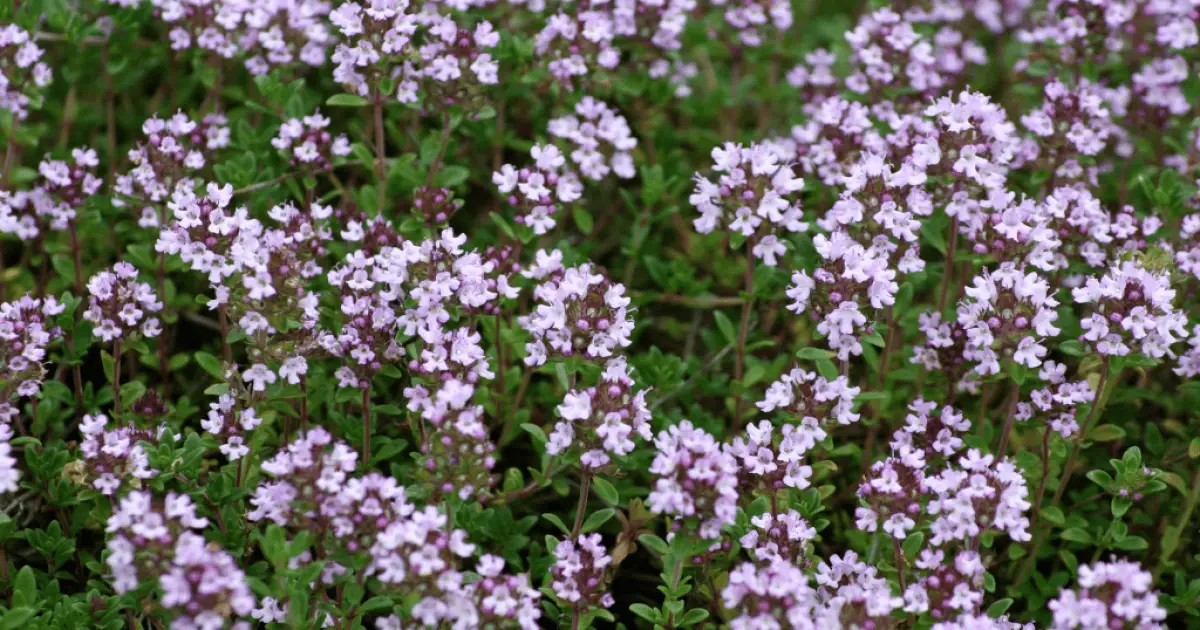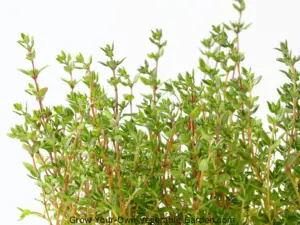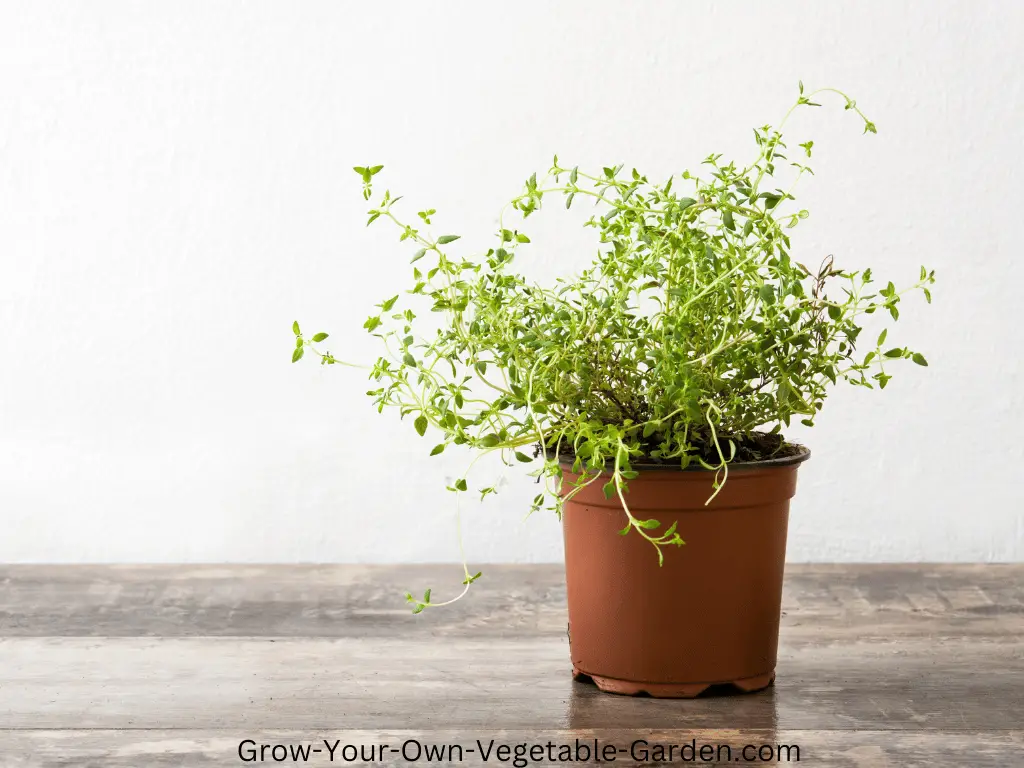
How To Grow Thyme Plants
What Is Thyme
Thyme is a perennial shrub belonging to the mint family Lamiaceae and is a highly aromatic herb renowned for its culinary and medicinal applications. Thyme plants are characterized by their small, fragrant leaves and flowers in the summer. These flowers are small but are loved by bees and others, making this an excellent addition to attract pollinators to your garden.
Originally native to the Mediterranean, its popularity and relative ease to grow has ensured it’s spread across the world. It is a relatively compact shrub that, on average, grows to about 20inches, making it a great addition for even space restricted gardens. However, as it has a carpet-like spread, it can be used to fill in gaps in your patio and rockery.
Thyme is not only a versatile herb in the kitchen but also a hardy perenial, coming back year after year with proper care. In colder climates, it can be grown in pots and brought indoors during winter or covered in a mulch to protect it from harsher temperatures.
Varieties Of Thyme
Thyme plants come in many different varieties with each having its own set of characteristics and benefits. Not all varieties of thyme are suitable for use in food so make sure you check first.
There are far too many to list so here are a few of my favourite examples;
Common Thyme
Common thyme (Thymuse Vulgaris) is basically regular thyme and produces the flavour and aroma you imagine when you think of thyme. It’s characterized by small leaves and small pink to purple flowers. This is a great choice for culinary use, producing that earthy and slightly minty flavour.
Spanish Thyme or Mastic Thyme
Thymus Mastichina, not to be confused with Cuban Oregano, is an upright thyme plant that is common across the Iberian Peninsula in Spain and Portugal. It produces small white flowers and a flavour / aroma similar to a cross between thyme and oregano.
Lemon Thyme
Thymus Citiodorus is an absolute favourite of mine, growing to about 4inches tall by 12inches in spread and producing pinkish flowers. As the name suggests this produces an amazing lemon scent and flavour making it fantastic in both the garden and kitchen.

Planting Thyme
How to grow thyme? Well, thyme plants thrive in well-drained, sandy or loamy soils with a slightly alkaline pH. When planting out choose a sunny spot that receives plenty of direct sunlight each day.
From Seed – If you’re growing thyme from seed then you need to sow them indoors about 6-8 weeks before the last frost. Once germinated with the first leaves showing, you need to prick them out into plug trays or pots and then allow them to establish.
When transplanting seedlings, ensure you space them about 12 –18 inches apart to allow for spread.
Alternatively, you can wait until the earth warms up slightly and then sow directly in place in your garden.
From Thyme Seedlings – as with many plants, just about the easiest was to grow thyme is to pop down the garden supplier and get some nice and healthy seedlings.
Once the soil has warmed slightly then just plant them directly where you want them, making sure to space them 12 – 18 inches apart.
From Thyme Cuttings – a great option if you have access to an already established plant. Cut a good looking sprig of about 8 inches in length, remove any growth in the bottom three inches before dipping in rooting powder. Now take a pot with a good potting soil and push the stripped sprig down into it, right up to the first leaves.
Put this on a window-sill in plenty of light and keep the soil moist. Once these cutting have established some good roots and the soil has warmed up outside, plant the cuttings directly in place in your garden.

Caring For Thyme
Thyme is relatively low-maintenance once it is established, making it pretty easy and stress-free to care for.
It won’t need a lot of watering as they prefer slightly dry conditions and the use of fertilizer is not essential but a little organic liquid fertilizer every now and then wont hurt.
Regular harvesting encourages bushiness so don’t hesitate to snip off sprigs as needed. Additionally, thyme plants can benefit from occasional pruning to keep them healthy and compact.
Thyme Pests And Problems
One of the main concerns with thyme is aphids which can distort leaves and stunt the plants growth. They will often congregate on the underside of leaves, leading to a sticky residue known as honeydew, which can attract other pest and cause fungal issues.
Spider mites are another potentially significant threat, especially in dry conditions. They feed on the plants sap and can cause stippling on leaves, eventually leading to yellowing and leaf drop.
Using natural pest control methods, such as attracting beneficial insects like ladybugs and lacewings or using insecticidal soaps, can help reduce pest populations without harming the plant or soil.
Powdery mildew can sometimes present as an issue but is relatively easily prevented by ensuring the plant is in a bright and sunny spot, selectively pruned and generally allowed good airflow.
Uses For Thyme
Cooking With Thyme – Thyme is a wonderfully versatile herb that can add some amazing flavours and aromas to your cooking. The leaves are great, picked fresh from the plant or work brilliantly as a dried herb. The strength profiles differ from fresh to dried so play around with quantities to figure out what works for you. It works really well in stews and hearty soups but can be added to so many other dishes that you will never run out of ideas. And if you’re growing lemon thyme then give it a go with some chicken – amazing!
Thyme Tea – Making thyme tea is pretty straightforward and allows you to enjoy the aromatic and flavorful benefits of this herb.
To get started, you’ll need fresh or dried thyme. If you’re using fresh thyme, about a handful of sprigs should suffice, while a teaspoon of dried thyme will work well for dried varieties. Place your chosen thyme into cup and pour over some boiling water. If you like a stronger flavour, allow the thyme to steep for about 10-15 minutes or a bit less for a less potent hit.
You can then strain the tea into your favourite cup, discarding the thyme leaves. For added sweetness, consider mixing in honey or a splash of lemon juice, both of which can enhance the flavors while offering additional health benefits. Thyme tea is not only soothing and aromatic but also packed with antioxidants and can allegedly help with various ailments, such as sore throats and coughs. Enjoy your homemade thyme tea warm or chilled, as you prefer.
Thyme FAQ’s
How do I store thyme – Storing thyme properly is essential to maintaining its flavor and freshness for as long as possible. If you have fresh thyme, the best way to store it is by treating it like a bouquet of flowers. Cut the stems and place them upright in a glass of water, ensuring the cut ends are submerged. Cover the leaves loosely with a plastic bag and store it in the refrigerator. This method can keep the thyme fresh for up to a week. Alternatively, you can wrap the thyme in a damp paper towel and place it inside a plastic bag in the fridge to preserve its moisture.
How do I make dried thyme – For longer storage, you can dry out some of your thyme. To do this, tie small bunches of thyme together with string and hang them upside down in a warm, dry place away from direct sunlight. Once the leaves are fully dried, you can strip them from the stems and store them in an airtight container, away from light and heat. Dried thyme can last for several months and can be used in a variety of recipes.
Can I freeze thyme – Absolutely, thyme can be frozen; simply chop the leaves and store them in an ice cube tray with water or olive oil. This will allow you to have fresh thyme on hand for cooking throughout the year.



